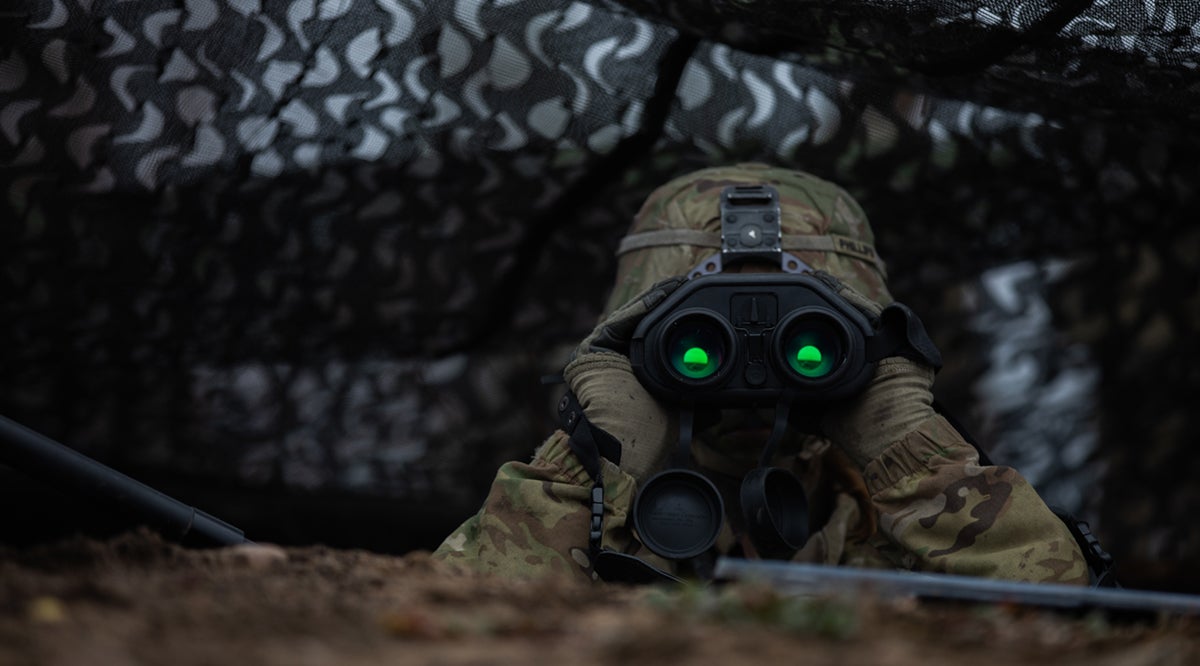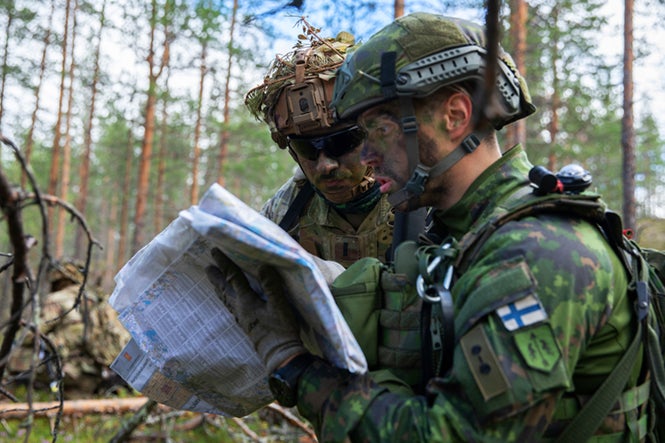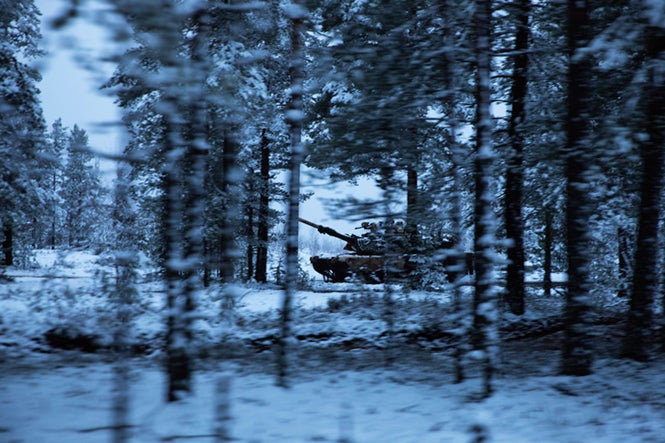Bittersweet New Member: Finland-Russia Border Vulnerabilities to NATO
Bittersweet New Member: Finland-Russia Border Vulnerabilities to NATO

by Maj. Brennan M. Gallagher, USAF
Landpower Essay 23-5, July 2023
In Brief
- The admission of Finland to NATO strengthens the alliance’s eastern flank, increases the available military resources and facilitates greater intelligence, surveillance and reconnaissance (ISR) data collecting; yet the 1,340 kilometers of new border also introduces new vulnerabilities for NATO.
- Finland’s accession to NATO, the construction of stronger border security by the Finns and the success or failure of Russian forces in Ukraine complicate tensions at the Russia-Finland border.
- NATO’s expanded border with Russia presents a precarious security dilemma for Russia, will open the door to illegal immigration and terrorism in Finland, and makes defense against a military incursion far more challenging. Considering these potential consequences, the history of the Finland-Russia border and the current short-term drivers, Finland, NATO and Europe are in potential danger.
- Officials from NATO must be aware of these border weaknesses and implement countermeasures in order for the advantages of Finland’s participation to outweigh the strategic dangers of an expanded border with Russia.
Introduction
Historically, Finnish political leaders have supported positions of nonalignment to reap the benefits of strategic ambiguity. Yet on 4 April 2023, flagbearers raised the Finnish flag at the NATO Headquarters in Brussels, Belgium.1 NATO officials welcomed the newest member and with recent concurrences from Turkey and Hungary, Sweden will start NATO accession protocols soon.2 Finland joined NATO for membership benefits, including collective defense, access to troops, equipment, military funding and deterrence,3 and NATO officials openly accepted Finnish membership to bolster the alliance’s eastern flank and increase the collective defenses in northern Europe.
Finland’s membership has more than doubled NATO’s border with Russia by adding the 1,340-kilometer Finnish-Russian border to the previous 1,213 kilometer border between Russia and NATO members Latvia, Estonia, Poland and Lithuania. The newly added Finnish-Russian border poses significant vulnerability and liability for NATO due to its provocation of Russian President Vladimir Putin, access to irregular migration and terrorists and lack of security against conventional and irregular warfare forces.
Historical Context
The history of the Finland-Russia border provides context for the vulnerabilities to NATO. The 1809 Treaty of Fredrikshamn, ending the war between Russia and Sweden, ceded Finnish provinces to Russian authorities.4 Before the treaty, the Russian government declared that “Finland was for all time united with the Russian empire and that the Finns had consequently taken the oath of allegiance to the Tsar.”5 Previous Russian autocracies therefore considered Finland part of the Russian empire, and the modern border is deemed irrelevant.
The next historical adjustment to the Finland-Russia border occurred in 1920 with the Treaty of Tartu. The treaty transferred a part of Russian territory to Finland and contained provisions for Russians in the Petschenga area to become Finnish citizens.6 After the treaty, Finnish soldiers supported the East Karelian uprising against the Soviets. These actions further increased the complexity and inviolability of the Finland-Russia border.
During World War II, General Secretary of the Communist Party of the Soviet Union Joseph Stalin severely suppressed Russia’s Finnish-speaking population and invaded Finland in the Winter War of 1939–1940 and again in the Continuation War in 1941–1944.7 The Treaty of Paris in 1947 demarcated the land border ceding significant Finland territory to the Soviet Union. Soviet and Finnish leaders adapted to the new land border despite neither being content.8 The volatility of the Russia-Finland border continued to grow during the Cold War.
During the Cold War, the Russia-Finland border offered a reliable, though lengthy, avenue for Russian defectors to reach Western officials and intelligence officers. Thus, tensions between the Soviet Union and Finland alternated between suspicion and confidence. The Soviets never planned to encroach on Finnish territory by force, but Finland’s nonalignment policies made Soviet officials uneasy.9 The Soviets and Finns increased border security, including the establishment of a border zone and increased surveillance and patrols. After the Cold War, tensions decreased, but some standard border protection mechanisms remained until Finland joined NATO.

Army First Lieutenant Christopher Robertello coordinates grid points with a Finnish soldier during Exercise Ryske 22 at Rovajarvi Training Area, Finland, 28 July 2022. The training exercise, involving the U.S., Finland and Norway, aims to strengthen relations and help build interoperability (U.S. Army photo by Specialist Austin Steinborn).
Short-Term Drivers
The dynamics and short-term drivers of the Finland-Russia border vulnerabilities include Finland’s integration into NATO, the Finns’ construction of more robust border protection and the success or failure of Russian forces in Ukraine. Finland’s acceptance into NATO places considerable pressure on Putin and the Russian government, and any adverse actions, including defensive posturing, could incite further Russian aggression toward Finland. Additionally, the outcome of the Russia-Ukraine conflict—and Ukraine’s desire to join the alliance—will affect how Putin perceives NATO, including its newest member. These drivers influence the vulnerabilities and liabilities of NATO’s additional 1,340-kilometer Finnish-Russian border.
Finland is currently participating in the Partnership for Peace Planning and Review Process and the Operational Capabilities Concept to determine how best to integrate Finnish military forces into the NATO framework. Finland also now participates in the Strategic Airlift Capability program, likely resulting in an increased NATO presence in Finland. Finnish and NATO forces will continue collaborating and cooperating as the military relationship matures. These increased NATO activities near Russia will further strain the relationship between Finland and Russia, raising tensions along the border.
The Finns’ ongoing construction of barriers along the Russian border veritably creates additional vulnerability for NATO in terms of a classic security dilemma—increase of one state’s security tends to decrease that of others.10 In February 2023, a Finnish construction company began building a 200-kilometer border fence with barbed wire on top, boosting security. In the past, the Finnish government accepted light wooden fences as border demarcation and security but decided to build this new barrier due to the number of Russians seeking to escape military conscription rather than fight in the war with Ukraine.11 Finnish officials could increase security measures by leveraging access to NATO technologies such as enhanced satellite services and complete access to NATO’s Intelligence Fusion Center, offering enhanced intelligence sharing between alliance members.12 These advanced capabilities, including the border barrier, increase Putin’s security dilemma.
Russia’s success or failure in Ukraine will likely increase resolve for or restrain aspirations of post-Cold War Russian expansionism. If Ukraine were to capitulate and allow Putin to achieve his strategic objective, his ambitions could increase. Since 2008, NATO leaders have discussed Ukrainian alliance membership without a formal offer. The potential of Ukraine joining NATO—and the increased security that membership in the alliance would provide—is viewed by Putin as a direct threat, and Russia has responded with escalating security measures.13 Putin also views Finland’s membership as a direct threat but is likely too preoccupied with the current war effort to consider any military reaction to Finland’s membership. These three drivers increase tensions between Finnish and Russian officials, making the Finland-Russia border a new liability for NATO.
Future Implications
The addition of Finland to Russia’s NATO border complicates matters on both sides, to include inciting a security dilemma for Putin, creating an approach for irregular migration and terrorists and a lack of border protection against military forces. These future implications, in conjunction with the history of the Finland-Russia border and applied to the current short-term drivers, pose significant threats to Finland, NATO and Europe. NATO officials must acknowledge and work to counter these implications.
The axiom that the only secure Russian border is the one with a Russian soldier standing on both sides still holds today.14 Powerful arguments against NATO enlargement included NATO members’ lack of preparation for a security guarantee and some Eastern European countries’ inability to assume the responsibilities of NATO membership. Moreover, Russian officials will inevitably view NATO enlargement as aimed against Moscow. This concern represents Putin’s security dilemma over Finland’s membership with NATO.15 Furthermore, Putin’s past experiences with NATO will influence his expectations for Finland. NATO’s 1999 bombing campaign against the Federal Republic of Yugoslavia, development of a missile defense system in Europe in 2002 and acceptance of the Vilnius Group membership against Russian officials’ requests will all impact his future decisionmaking.16 Putin likely views Finland as complicit in previous alliance actions and apt to commit similar activities against the Russian Federation.
The previous NATO-Russia border included Estonia, Latvia and Poland. The Russian military maintains significant weapons systems in Kaliningrad to protect its interests along the NATO border. Russia has replaced outdated T-72 tanks with modernized T-72B3M variants and added additional artillery systems to the garrison there, and missile systems in the enclave could rapidly strike bases, naval vessels and aircraft in the Baltic Sea and surrounding countries.17 Putin’s resolve to protect his border continues with the Finns’ new expansion. Andrei Demin, the deputy commander of Russian aerospace forces, remarked, “Under these conditions, air defense troops are practicing the protection of the state border in the northwest in accordance with the increased threat level.”18 In September 2016, Russia moved two S-400 antiaircraft missile systems near the Finnish border in response to Finnish President Sauli Niinistö’s initial talks of joining NATO.19 Putin may also utilize additional border surveillance equipment and increase military patrols to further secure the expanded border between Russia and NATO.

An Abrams tank speeds through the trees in a snow-covered forest during Hammer 22, an annual combined forces exercise conducted by and alongside the Finnish Army in Niinisalo, Finland, 9 November 2022 (U.S. Army photo by Specialist Charles Leitner).
Irregular migration across the Finland-Russia border poses a direct threat to Finland and a consequential threat to NATO. Irregular migration is illegal immigration or “movement outside of regulatory norms of the sending, transit, or receiving country,” and occurs from Russia to Finland and other Nordic countries.20 This irregular migration into Finland creates four threats. First, increased refugees, conscription avoiders and Russian and non-Russian migrants seeking access to Europe across the large unsecured border has negative impacts on the socioeconomic structure of Finland. Unemployment, informal economies and welfare burdens increase with irregular migration. The second threat is the security of human mobility across a sovereign border. Unsecured borders bring into question the viable sovereignty of Finland and the NATO alliance. Third, the clash of non-Finnish migrants with the societal, national and demographic identities in large Finnish cities may increase local and national tensions. Lastly, irregular migration impacts the political equilibrium by increasing domestic anti-migrant, xenophobic and nationalist rhetoric.21 Such rhetoric could lead to more and larger right-wing, conservative movements changing Finland’s political landscape.
Two consequential subsets of Finnish irregular migration across the Finland-Russia border are terrorism and organized crime.22 The human mobility and ease of access across the unsecured portions of the border may offer additional malicious individuals access to Finland, other Nordic countries and Europe at large. For example, the civil war and recent earthquake in Syria have caused a major refugee crisis in Europe, especially in the Republic of Turkey. The European Union agreed with Turkey to limit asylum seekers and prevent more migratory routes from opening.23 Irregular migrants, including terrorists, smugglers and human traffickers, could develop northern migratory routes through Russia and Europe. Unlike Turkey, a NATO member, Russian officials care little about irregular migration into Europe and are unlikely to pursue any mechanisms to counter eastward migration. The largely unprotected border therefore provides easy access to Finland and Europe for terrorists and organized crime, a clear potential threat to NATO members.
The last implication is ground border security. Even though Finnish officials have elected to build a ten-foot-tall border barrier topped with barbed wire across the southernmost 200 kilometers, the remaining 1,000 kilometers provides minimal westbound security measures. This unprotected border offers access to Finland for conventional or irregular warfare forces. Irregular warfare forces, such as Russian special operations forces (SOF), could cross the border at night or during inclement weather undetected. Covert Russian SOF could then advance deeper into Finland, Sweden or elsewhere in Europe across the Baltic Sea to conduct hybrid operations. Furthermore, Russian forces could easily surpass border security mechanisms and access the Finnish railway and highway systems in a future conflict. This accessibility would provide Russian troops with an off-axis approach against NATO forces.
A counterargument against the Finland-Russia border being a vulnerability to NATO includes the additional forces provided by the Finnish military; better intelligence, surveillance and reconnaissance (ISR) access provided by the NATO border expansion; and the dilution of Russian troops and resources along the border. The Finnish Defense Forces (FDF) include approximately 22,000 military members and a large reserve, providing a fully mobilized endstrength of approximately 280,000.24 The FDF could deploy to better secure the Finland border. Additionally, Finland’s NATO membership offers NATO ISR platforms increased access and proximity to Russian forces. Lastly, Russian military leaders may elect to dilute their ground forces, airborne assets and surface-to-air missile systems to expand along the unsecured Finland-Russia border. This expansion limits the protection of Russian interests elsewhere, offering operational opportunities for NATO. However, deploying the FDF, improving border surveillance and diluting Russian forces does not necessarily mitigate the 1,340-kilometer border vulnerabilities.
Conclusion
Finland’s membership in NATO provides countless benefits to the alliance, including improved collective defense, deterrence and operational expansion. However, the Finnish-Russian border also poses several vulnerabilities for NATO because of Putin’s view of NATO expansion, avenues for irregular migration and terrorists and limited countermeasures against conventional and irregular warfare forces. NATO officials must acknowledge these vulnerabilities and identify and develop mechanisms to counter them. Otherwise, the benefits of Finland’s membership will not outweigh the strategic vulnerabilities of an unsecured border against Russia.
★ ★ ★ ★
The views and opinions expressed herein are those of the author alone and do not necessarily reflect the official policy or position of the U.S. Air Force, the Department of Defense or the U.S. government.
Major Brennan Gallagher, United States Air Force, is an Action Officer assigned to the Commander’s Action Group at Headquarters U.S. Air Forces in Europe and Air Forces Africa at Ramstein Air Base, Germany. He previously served as a graduate student at the National Intelligence University in Bethesda, Maryland. He is an HC-130J rescue pilot with operational experience in the Middle East, North Africa and the Horn of Africa. Gallagher has a Master of Science of Strategic Intelligence, an MA in Management from the University of Alabama and a BS in Biology from the United States Air Force Academy.
- Hans Binnendijk and Conor Rodihan, “Finnish and Swedish Nonalignment and Defense Postures,” in Geometries of Deterrence: Assessing Defense Arrangements in Europe’s Northeast (Washington, DC: Atlantic Council, 2020), 10.
- Andras Gegely, “Hungary Backs Sweden’s NATO Accession, Foreign Minister Says,” Bloomberg, 11 July 2023.
- “10 Things You Need to Know about NATO,” Fact Sheet, North Atlantic Treaty Organization, December 2015.
- “Finland.” American Political Science Review 4, no. 3 (1910): 350.
- “Finland,” 351.
- Jessica Fagerlund, “Finland,” in Acquisition and Loss of Nationality Volume 2: Country Analyses: Policies and Trends in 15 European Countries, ed. Rainer Bauböck, Eva Ersbøll, Kees Groenendijk and Harald Waldrauch (Amsterdam: Amsterdam University Press, 2006), 155.
- Fagerlund, “Finland,” 155.
- Kalevi J. Holsti, “Strategy and Techniques of Influence in Soviet-Finnish Relations,” Western Political Quarterly 17, no. 1 (1964): 65.
- Klaus Törnudd, “Finnish Neutrality Policy during the Cold War,” SAIS Review of International Affairs 25, no. 2 (2005): 46.
- Robert Jervis, “Cooperation under the Security Dilemma,” World Politics 30, no 2, 1978, 167.
- George Wright, “Finland Starts Construction of Russia Border Fence,” BBC News, 28 February 2023.
- Joseph S. Gordon, “Intelligence Sharing in NATO,” Atlantisch Perspectief 41, no 6 (2017): 17; NATO, “Satellite Communications,” Topics, last modified April 23, 2021.
- Ivo Daalder, “Let Ukraine In,” Atlantic, 21 April 2022.
- Keir Giles, Moscow Rules: What Drives Russia to Confront the West (Washington, DC: Brookings Institute Press, 2019), 36.
- Joris Van Bladel, “Mobilizing against Russia? Some Reflections on the Security Deadlock Called Ukraine,” Egmont Paper 115, Egmont Royal Institute of International Relations, March 2022, 21.
- Van Bladel, “Mobilizing against Russia,” 24.
- Sebastien Roblin, “Fortress Kaliningrad: Russia’s Baltic Fleet Now Has a Mechanized Division,” National Interest, 20 March 2021.
- “Russia Says Ramping Up Border Defense as Finland Enters NATO,” Moscow Times, 11 April 2023.
- YLE News, “Russia Moves Missiles to Finnish Border,” Barents Observer, 26 September 2016.
- “Irregular Migration,” Migration Data Portal, Global Migration Data Analysis Centre, last modified 29 September 2022.
- Susana Ferreira, Human Security and Migration in Europe’s Southern Borders (London: Palgrave Macmillan, 2018), 70.
- Ferreira, Human Security and Migration, 71.
- Kyilah Terry, “The EU-Turkey Deal, Five Years On: A Frayed and Controversial but Enduring Blueprint,” Migration Information Source, Migration Policy Institute, 8 April 2021.
- Hiljä Ossa and Tommi Koivula, “What Would Finland Bring to the Table for NATO?" War on the Rocks, 9 May 2022.
The views and opinions of our authors do not necessarily reflect those of the Association of the United States Army. An article selected for publication represents research by the author(s) which, in the opinion of the Association, will contribute to the discussion of a particular defense or national security issue. These articles should not be taken to represent the views of the Department of the Army, the Department of Defense, the United States government, the Association of the United States Army or its members.

